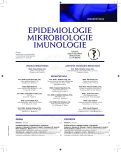Klinická a mikrobiologická charakteristika závažných infekcií spôsobených streptokokmi skupiny A
Authors:
H. ✝hupková 1; M. Záborská 1; V. Šišovský 2; P. Babál 2; M. Šimaljaková 3; M. Koreň 4; R. Reis 5; J. Kozáková 6; D. Bičan 1
Authors‘ workplace:
Mikrobiologický ústav LF UK a UNB, Bratislava
1; Ústav patologickej anatómie, LF UK a UNB Bratislava Úrad pre dohľad nad zdravotnou starostlivosťou Bratislava
2; Dermatovenerologická klinika LF UK a UNB Bratislava
3; I. interná klinika LF UK a UNB Bratislava
4; II. chirurgická klinika LF UK a UNB Bratislava
5; Národné referenčné laboratórium pre streptokokové nákazy SZU Praha
6
Published in:
Epidemiol. Mikrobiol. Imunol. 63, 2014, č. 3, s. 164-167
Category:
Review articles, original papers, case report
Overview
Aim of the study:
Data analysis of the occurrence of severe infections caused by A-group of streptococci, emm typing of the isolated strains, and survey of resistance to the selected antibiotics.
Material and methods:
During the years 2012 and 2013, forty-three S. pyogenes strains were isolated from severe infections. The S. pyogenes strains were most frequently isolated from wounds and abscesses (36 patients), followed by isolations from haemocultures (5 patients), sputum (1 patient), autopsy samples (1 patient). The antimicrobial susceptibility to the selected antibiotics (penicillin, erythromycin, clindamycin, spiramycin, tetracycline) was detected by the disk-diffuse method, and the minimal inhibitory concentrations (MICs) were measured as well.
Results:
During the years 2012 and 2013, an increase of occurrence of severe streptococcal infections was detected: 27 and 16 cases, respectively. Resistance to macrolides was detected in 18, 5 % and 12, 5 %, to tetracyclines in 25, 9 % and 20 %, respectively. The emm type 1 was the most frequently detected in the isolated S. pyogenes strains. The risk factors for streptococcal infection development were followed up; injury was the most frequently detected – in 7 and 2 patients, respectively. The patients were most frequently treated by betalactam antibiotics (penicillin, ampicillin). In the year 2012, two cases were lethal.
Conclusion:
This study describes the cases of invasive Group A Streptococcal (GAS) infection as seen in hospital clinical practice. We detected an increased occurrence of S. pyogenes in the hospital; an increased resistance to erythromycin and tetracycline was detected as well. It is necessary to monitor the trends of antimicrobial resistance and the occurrence of emm types of isolated strains. Cooperation of the laboratory and clinical settings in the prevention and the therapy of streptococcal infections, first of all of the invasive ones, is important for the risk decrease of their occurrence.
Keywords:
Streptococcus pyogenes – závažné infekcie – rizikové faktory – emm typ
Sources
1. Luca-Harari B, Darenberg J, Neal S, Siljander T, et al. Clinical and Microbiological Characteristics of Severe Streptococcus pyogenes Disease in Europe. J Clin Microbiology, 2009; 47:1155–1165.
2. Straková L, pracovní skupina Strep-EURO., Motlová J, Urbášková P, Křížová P. Surveillance závažných onemocnění způsobených streptokoky skupiny A v České republice v roce 2003 - project Strep-EURO. Epidemiolog Mikrobiol Imunol, 2004;53:106–111.
3. Johansson L, Thulin P, Low DE, Norrby-Teglund A. Getting under the Skin: The Immunopathogenesis os Streptococcus pyogenes Deep Tissue Infections. Clinical Inf Dis, 2010;51(1):58–65.
4. Lamagni TL, Efstratiou A, Vuopio-Varkila J, Jasir A, et al. The epidemiology of severe Streptococcus pyogenes associated disease in Europe. Eurosurveillance, 2005;10:179–184.
5. Cole JN, Barnett TC, Nezet V, Walker MJ. Molecular insight into invasive group A streptococcal disease. Nat Rev Microbiol, 2011, 9(10):724–736.
6. Lynskey NN, Lawrenson RA, Sriskandan S. New understandings in Streptococcus pyogenes. Curr Opin Infect Dis, 2011;24(3):196–202.
7. Olsen RJ, Musser JM. Molecular pathogenesis of necrotizing fasciitis. Annu Rev Pathol, 2010;5:1–31.
8. Lamagni TL, Neal S, Keshishian C, Alhaddad N, et al. Severe Streptococcus pyogenes iInfections, United Kingdom, 2003-2004. Emer Infect Dis, 2008;14(2):201–209.
9. Steer AC, Law I, Matatolu L, Beall BW, et al. Global emm type distribution of group A streptococci: systematic review and implications for vaccine development. The Lancet Inf Dis, 2009;9(10):611–616.
Labels
Hygiene and epidemiology Medical virology Clinical microbiologyArticle was published in
Epidemiology, Microbiology, Immunology

2014 Issue 3
Most read in this issue
- The current view of the diagnosis and management of amebiasis in the light of the authors’ own case reports
- Infections caused by human alpha herpes viruses
- Enterohemorrhagic Escherichia coli as the cause of diarrhea in the Czech Republic, 1965–2013
- Occurrence and characteristic of Staphylococcus aureus in pork meat
